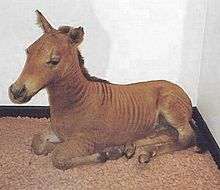Zebroid
A zebroid is the offspring of any cross between a zebra and any other equine to create a hybrid. In most cases, the sire is a zebra stallion. Offspring of a donkey sire and zebra dam called a donkra or zebra hinny and offspring of a horse sire and a zebra dam called a hebra do exist, but are rare and are usually infertile. Zebroids have been bred since the 19th century. Charles Darwin noted several zebra hybrids in his works.
| Zebroid | |
|---|---|
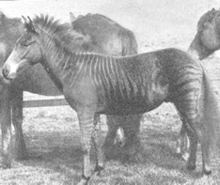 | |
| A zorse in an 1899 photograph, "Romulus: one year old", from J. C. Ewart's The Penycuik Experiments | |
| Scientific classification | |
| Kingdom: | Animalia |
| Phylum: | Chordata |
| Class: | Mammalia |
| Order: | Perissodactyla |
| Family: | Equidae |
| Tribe: | Equini |
| Genus: | Equus |
| Species: | |
Types
Zebroid is the term generally used for all zebra hybrids. The different hybrids are generally named using a portmanteau of the sire's name and the dam's name. Generally, no distinction is made as to which zebra species is used. Many times, when zebras are crossbred, they develop some form of dwarfism. Breeding of different branches of the equine family, which does not occur in the wild, generally results in infertile offspring. The combination of sire and dam also affects the offspring phenotype.
A zorse is the offspring of a zebra stallion and a horse mare. This cross is also called a zebrula, zebrule, or zebra mule. The rarer reverse pairing is sometimes called a hebra, horbra, zebrinny, zebret, or zebra hinny. Like most other animal hybrids, the zorse is sterile.[1]
A zony is the offspring of a zebra stallion and a pony mare. Medium-sized pony mares are preferred to produce riding zonies, but zebras have been crossed with smaller pony breeds such as the Shetland, resulting in so-called "Zetlands".[2]
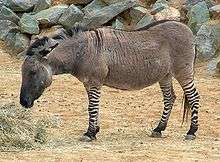
A cross between a zebra and a donkey is known by many terms, including: zonkey,[3] (a term also used for donkeys in Tijuana, Mexico painted as zebras for tourists to pose with them in souvenir photos)[4] zebonkey, zebronkey, zebrinny, zebrula, zebrass, zedonk, and zebadonk. Donkeys are closely related to zebras and both animals belong to the horse family. These zebra/donkey hybrids are very rare.[5][6] In South Africa, they occur where zebras and donkeys are found in proximity to each other. Like mules and hinnys, however, they are generally genetically unable to breed, due to an odd number of chromosomes disrupting meiosis.
Genetics
Living equids show wide variation in the number of chromosomes, ranging from a diploid number of 32 chromosomes in the mountain zebra to 66 in Przewalski's horse. This is due to several chromosomal fusion and fission events during the evolution of equids.[7] The zebra has between 32 and 46 chromosomes depending on the species.
In spite of this difference, viable hybrids are possible, provided the gene combination in the hybrid allows for embryonic development to birth. A hybrid will have a number of chromosomes exactly halfway between that of its parents; for example, a cross between a horse (64 chromosomes), and a plains zebra (44 chromosomes), will produce a zebroid offspring with 54 chromosomes. The chromosome difference makes female hybrids poorly fertile and male hybrids generally sterile, due to a phenomenon called Haldane's rule. The difference in chromosome number is most likely due to horses having two longer chromosomes that contain similar gene content to four zebra chromosomes.[8]
Just as male mules and hinnies are infertile so are male zebroids. And just as female mules and hinnies only very rarely produce offspring the same appears to be true of zebroids. Considering zebroids are much less common as mules the chances of a fertile zebroid mare are very slim. Only ONE case of such a mare was reported : The zebroid mare of a zebra mare x draft horse stallion produced a foal when she was bred back to her sire but the foal died of lightning and she did not survive it much longer.
Extant Equus species: chromosome number
| Subgenus | Scientific name | Common name | Chromosome number (2n) |
|---|---|---|---|
| Hippotigris
(Zebras) |
Equus zebra | Mountain zebra | 32 |
| Equus grevyi | Grévy's zebra | 46 | |
| Equus quagga | Plains zebra | 44 | |
| Asinus
(wild asses) |
Equus africanus | African wild ass; includes domesticated donkey | 62 |
| Equus hemionus | Onager, hemione, or Asiatic wild ass | 56 | |
| Equus kiang | Kiang | 52 [9] | |
| Equus | Equus ferus caballus | Domesticated horse | 64 |
| Equus ferus przewalskii | Przewalski's horse | 66 [10] |
Zebras are more closely related to wild asses (a group which includes donkeys) than to horses. The horse lineage diverged from other equids an estimated 4.0 - 4.7 million years ago;[11] zebras and asses diverged an estimated 1.69–1.99 million years ago.[9] The cladogram of Equus below is simplified from Vistrup et al. (2013).[11]
| Equus |
| |||||||||||||||||||||||||||||||||||||||||||||
Physical characteristics
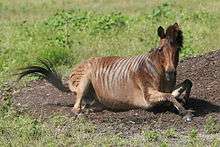
Zebroids physically resemble their nonzebra parent, but are striped like a zebra. The stripes generally do not cover the whole body, and might be confined to the legs or spread onto parts of the body or neck. If the nonzebra parent was patterned (such as a roan, Appaloosa, pinto/paint, piebald, or skewbald), this pattern might be passed down to the zebroid, in which case the stripes are usually confined to non-white areas. The alternative name "golden zebra" relates to the interaction of zebra striping and a horse's bay or chestnut colour to give a zebra-like black-on-bay or black-on-chestnut pattern that superficially resembles the extinct quagga. Zebra-donkey hybrids usually have a dorsal (back) stripe and a ventral (belly) stripe.
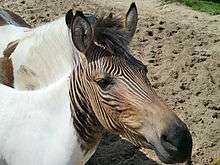
Zorses combine the zebra striping overlaid on colored areas of the hybrid's coat. Zorses are most often bred using solid-color horses. If the horse parent is piebald (black and white) or skewbald (other color and white), the zorse may inherit the dominant depigmentation genes for white patches. The tobiano (the most common white modifier found in the horse) directly interacts with the zorse coat to give the white markings. Only the nondepigmented areas will have zebra striping, resulting in a zorse with white patches and striped patches. This effect is seen in the zebroid named Eclyse (a hebra rather than a zorse) born in Stukenbrock, Germany, in 2007 to a zebra mare called Eclipse and a stallion called Ulysses.
Zebroids are preferred over zebras for practical uses, such as riding, because the zebra has a different body shape from a horse or donkey, and consequently it is difficult to find tack to fit a zebra. However, a zebroid is usually more inclined to be temperamental than a purebred horse and can be difficult to handle. Zebras, being wild animals, and not domesticated like horses and donkeys, pass on their wild animal traits to their offspring. Zebras, while not usually very large, are extremely strong and aggressive. Similarly, zorses have a strong temperament and can be aggressive.
Historical and notable zebroids
In 1815, Lord Morton mated a quagga stallion to a chestnut Arabian mare. The result was a female hybrid which resembled both parents. This provoked the interest of Cossar Ewart, Professor of Natural History at Edinburgh (1882–1927) and a keen geneticist. Ewart crossed a zebra stallion with pony mares to investigate the theory of telegony, or paternal impression. In Origin of Species (1859), Charles Darwin mentioned four coloured drawings of hybrids between the ass and zebra. He also wrote
In Lord Morton's famous hybrid from a chestnut mare and male quagga, the hybrid, and even the pure offspring subsequently produced from the mare by a black Arabian sire, were much more plainly barred across the legs than is even the pure quagga.[12]
In his book The Variation of Animals and Plants under Domestication, Darwin described a hybrid ass-zebra specimen in the British Museum as being dappled on its flanks. He also mentioned a "triple hybrid, from a bay mare, by a hybrid from a male ass and female zebra" displayed at London Zoo. This would have required the zebroid sire to be fertile.
During the South African War, the Boers crossed Chapman's zebras with ponies, to produce animals for transport work, chiefly for hauling guns. A specimen was captured by British forces and presented to King Edward VII by Lord Kitchener, and was photographed by W. S. Berridge.[13] Zebras are resistant to sleeping sickness, whereas purebred horses and ponies are not, and zebra mules hopefully would inherit this resistance.
Grevy's zebra has been crossed with the Somali wild ass in the early 20th century. Zorses were bred by the US government and reported in Genetics in Relation to Agriculture by E. B. Babcock and R. E. Clausen (early 20th century), in an attempt to investigate inheritance and telegony. The experiments were also reported in The Science of Life by H G Wells, J Huxley, and G P Wells (around 1929).
Interest in zebra crosses continued in the 1970s. In 1973, a cross between a zebra and a donkey was foaled at the Jerusalem Zoo. They called it a "hamzab". In the 1970s, the Colchester Zoo in England bred zedonks, at first by accident and later to create a disease-resistant riding and draft animal. The experiment was discontinued when zoos became more conservation-minded. A number of hybrids were kept at the zoo after this; the last died in 2009.[14] One adult still remains at the tourist attraction of Groombridge Place[15] near Tunbridge Wells in Kent.
21st century
Today, various zebroids are bred as riding and draft animals, and as curiosities in circuses and smaller zoos. Zorses are bred in Africa and used for trekking on Mount Kenya;[16] the zebra parent gives resistance to the nagana pest disease. A zorse (more accurately a zony) was born at Eden Ostrich World, Cumbria, England, in 2001, after a zebra was left in a field with a Shetland pony. It was referred to as a Zetland. Usually, a zebra stallion is paired with a horse mare or donkey mare, but in 2005, a Burchell's zebra named Allison produced a zonkey called Alex sired by a donkey at Highland Plantation in the parish of Saint Thomas, Barbados. Alex, born 21 April 2005, is apparently the first zonkey in Barbados.[17] In 2007, a stallion, Ulysses, and a zebra mare, Eclipse, produced a hebra named Eclyse, displaying an unusually patchy color coating.[18][19] The Wild Animal Safari in Springfield, Missouri, and its sister location in Pine Mountain, Georgia, have several zonkeys as of 31 March 2010. In July 2010, a zonkey was born at the Chestatee Wildlife Preserve in Dahlonega, Georgia.[20] Another zebra–donkey hybrid, like the Barbados zonkey sired by a donkey, was born 3 July 2011 in Haicang Safari Park, Haicang, Xiamen, China.[21] A zonkey, Ippo, was born 21 July 2013 in an animal reserve, in Florence, Italy.[22] Khumba, the offspring of a zebra dam and a dwarf albino donkey sire, was born on 21 April 2014 in the zoo of Reynosa in the state of Tamaulipas, Mexico.[23] More recently, in November 2018 at a farm in Somerset, a cross between a donkey stallion and a zebra mare was born.[24] The male foal was described as a zonkey by its owner and has been named Zippy.
Popular culture
Zorses have appeared in several TV shows and movies. In the Viva La Bam episode "Groundhog Day". in the final race, Brandon DiCamillo's sled is a zorse. It was colored pink, blue, purple. and red. On the 'uncommentary' on the DVD seasons of Viva La Bam, Tim Glomb says, "If you send me a list of all the episodes where the zorse is, I'll give you a dollar". The 2007 movie I'm Reed Fish features a zorse named Zabrina. In the movie Racing Stripes, an animated zorse appears in the alternate ending. He is the son of Stripes, a zebra stallion and Sandy, a grey Arabian mare.
Zorses have also appeared in books. They are briefly mentioned several times in George R.R. Martin's A Song of Ice and Fire series of fantasy novels.[25] Sutton Coleman wrote a sonnet about zorses and published it in his 2007 book, Ligers, Tigons, and Zorses, Oh My! In Roald Dahl's book Going Solo, several other characters and he speculate on how nice it would be to own a zorse, although they admit it would be difficult to train.
The fantasy setting Glorantha has a magical fertile breed of horses crossed with zebras based on the city of Pavis. This small population is extended by breeding stallions of these breeds with ordinary horses, creating an infertile breed called Cavalry Zebras.
The video game Red Dead Redemption has the "Zebra Donkey" available as a multiplayer mount, however this is a Mexican donkey painted to appear as a zebra, so is not an actual hybrid breed.
In El Tigre: The Adventures of Manny Rivera, the characters' school's mascot is the famed Zebra Donkey.
References
- "Zorse Breed Description". Breeding References. EquinePost. Archived from the original on 10 July 2011.
- Carter, Helen (27 June 2001). "Crisis-hit farm welcomes its gift forse". The Guardian. London. Retrieved 20 April 2010.
it could be a zorse perhaps, a fony, or maybe a shebra or a zetland. Whatever its name, the arrival of the strange beast has been hailed as a godsend
- "Here's everything you wanted to know about zonkeys, the great zebra-donkey hybrids". Public Radio International.
- Miranda, Carolina A. "How the zonkey got its stripes: Long before Instagram, Tijuana's tourist donkeys were camera-ready". latimes.com.
- Megersa, B; Biffa, D; Kumsa, B (13 February 2007). "A mysterious zebra-donkey hybrid (zedonk or zonkey) produced under natural mating: A case report from Borana, southern Ethiopia". Animal Production Research Advances. 2 (3). doi:10.4314/apra.v2i3.36328.
- Benirschke, K; Low, RJ; Brownhill, LE; Caday, LB; Devenecia-Fernandez, J (1 April 1964). "Chromosome Studies of a Donkey-Grevy Zebra Hybrid". Chromosoma. 15: 1–13. doi:10.1007/BF00326911. PMID 14171168.
- Musilova, P.; Kubickova, S.; Vahala, J.; Rubes, J. (27 March 2013). "Subchromosomal karyotype evolution in Equidae". Chromosome Research. 21 (2): 175–187. doi:10.1007/s10577-013-9346-z. ISSN 0967-3849.
- K. Benirschke; et al. (1964). "Chromosome Studies of a Donkey-Grevy Zebra Hybrid". Chromosoma. 15 (1): 1–13. doi:10.1007/BF00326911. PMID 14171168.
- Jónsson, Hákon; Schubert, Mikkel; Seguin-Orlando, Andaine; Ginolhac, Aurélien; Petersen, Lillian; Fumagalli, Matteo; Albrechtsen, Anders; Petersen, Bent; Korneliussen, Thorfinn S.; Vilstrup, Julia T.; Lear, Teri (30 December 2014). "Speciation with gene flow in equids despite extensive chromosomal plasticity". Proceedings of the National Academy of Sciences. 111 (52): 18655–18660. doi:10.1073/pnas.1412627111. ISSN 0027-8424. PMC 4284605. PMID 25453089.
- Lau, Allison N.; Peng, Lei; Goto, Hiroki; Chemnick, Leona; Ryder, Oliver A.; Makova, Kateryna D. (1 January 2009). "Horse Domestication and Conservation Genetics of Przewalski's Horse Inferred from Sex Chromosomal and Autosomal Sequences". Molecular Biology and Evolution. 26 (1): 199–208. doi:10.1093/molbev/msn239. ISSN 0737-4038.
- Vilstrup, Julia T.; Seguin-Orlando, Andaine; Stiller, Mathias; Ginolhac, Aurelien; Raghavan, Maanasa; Nielsen, Sandra C. A.; Weinstock, Jacobo; Froese, Duane; Vasiliev, Sergei K.; Ovodov, Nikolai D.; Clary, Joel (20 February 2013). Lalueza-Fox, Carles (ed.). "Mitochondrial Phylogenomics of Modern and Ancient Equids". PLOS One. 8 (2): e55950. doi:10.1371/journal.pone.0055950. ISSN 1932-6203. PMC 3577844. PMID 23437078.
- Darwin, Charles (2009). On the origin of species, 1859. New York: New York University Press. pp. 118–119. ISBN 978-0814720585.
- Wonders of Animal Life, edited by J. A. Hammerton (1930)
- "Colchester Zoo mourns the loss of Shadow the Zeedonk" (Press release). Colchester Zoo. 3 April 2009. Archived from the original on 8 July 2011.
- "The Enchanted Forest". Groombridge Place Gardens. Archived from the original on 29 July 2010.
- "Meet Eclyse - the amazing zebra crossing". Mail Online. London: Associated Newspapers Ltd. 28 June 2007. Archived from the original on 29 July 2012. Retrieved 10 July 2008.
- "Call it zonkey or a deebra? Zebra has a foal sired by a donkey". NBC News. Associated Press. 29 April 2005. Retrieved 13 October 2008.
- Amanda Billner. "Zebran är en häst" Archived 30 September 2007 at the Wayback Machine (in Swedish). Dagens Nyheter's webpage, 28 June 2007. Retrieved 30 June 2007.
- BBC "Half horse, half zebra - hebra Archived 4 September 2007 at the Wayback Machine Retrieved 3 July 2007]
- "Zebra, donkey hybrid born in Dahlonega". Gainesville Times. 27 July 2010.
- "Donkra: Cross between Donkey, Zebra born". 3 News. 5 July 2011.
- "It's a zonkey! Zebra and donkey hybrid born in Italy". Daily News. New York. Archived from the original on 27 July 2013.
- "Zonkey born in a zoo in Mexico". The Telegraph. 25 April 2014. Archived from the original on 26 April 2014. Retrieved 26 April 2014.
- "Rare cross between donkey and zebra known as 'zonkey' born on Somerset farm". The Independent. Retrieved 6 November 2018.
- "Zorse". westeros.org. Archived from the original on 13 March 2016. Retrieved 6 May 2018.
External links
| Wikimedia Commons has media related to Zorses. |
- Hybrid Equines Information and images of different zebroids
- Eclyse - Photo of a zebroid named Eclyse
- "Zenkey foal a hybrid star". The Sydney Morning Herald. Agence France-Presse. 29 August 2003.
- BBC News (26 June 2001): "Zebra Hybrid is Cute Surprise"
- Metro (28 June 2007): "A single-zorsed story"
- Dorsett, Katherine. "What the heck is a zedonk?" CNN. 23 September 2010.
- The International Zebra Zorse Zonkey Association
- Video of a Zorse
- Rare zebra-donkey mix born in Florence animal reserve: The zonkey named Ippo only one in Italy
